Ask Ethan # 108: Is there instant sunlight?
The sun receives energy through synthesis in the core. But can the light appear on its surface?
Birds sing after the storm; why shouldn't people rejoice at the sunshine allocated to them?
- Rose Kennedy
But still, in itself, the light of the Sun would be lethal for us if we met with it at the moment of its appearance. As always, you do not disappoint me with your questions and suggestions , and their spectrum stretches from inflation to black holes and anti-matter annihilation, but I choose only one question per week. This time kbanks64 asks:
I have heard many times that sunshine takes thousands of years to get from the center of the sun to the surface. I understand this, but I want to ask - is there any light created on the surface of the Sun to leave it immediately?
The sun is an interesting thing, and the light from the sun is an even more interesting thing! Let's figure it out.
')

If it were not for nuclear fusion, our native gravity would be the only source of solar energy. Lord Kelvin initially believed that the Sun will shrink over time, and that a huge amount of potential gravitational energy in the process is converted into heat emitted from its surface.
It was a great idea, but such a process would feed the Sun no more than 100 million years, which is completely inadequate from the point of view of geology and biology that we observe on Earth. Some stars - such as white dwarfs (including Sirius B in the picture above, having a mass comparable to that of the sun) - are fueled by such a Kelvin-Helmholtz mechanism, but their luminosity is several million times weaker than that of the Sun.
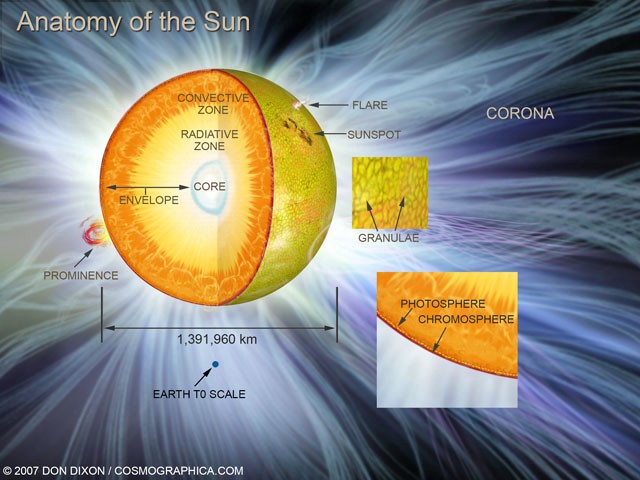
The light of the Sun is powered by nuclear fusion, in which heavy nuclei are synthesized from light nuclei, and a huge amount of energy (E = mc 2 ) and high-energy photons are emitted in the process.
But, as our reader points out, these reactions take place only in the nucleus, and a huge number of ionized atoms — protons, nuclei and free electrons — prevent these photons from reaching the surface of the Sun without first enduring a huge number of collisions. They produce a large number of much cooler photons, with wavelengths from the ultraviolet, visible and infrared ranges, instead of the original gamma radiation.

Nuclear fusion occurs in steps when two protons merge into a deuteron, then helium-3 or tritium is synthesized from deuterium, and helium-4 is synthesized from helium-3 or tritium with another deuteron, and the process produces byproducts of reactions in the form of protons and neutrons, as well as neutrinos and high-energy photons.
• Neutrinos freely leave the sun.
• High-energy photons undergo a tremendous amount of collisions, and going out takes tens to hundreds of thousands of years.
• Reaction products remain stable, decay, or participate in other reactions, but it all happens in the depths of the star.
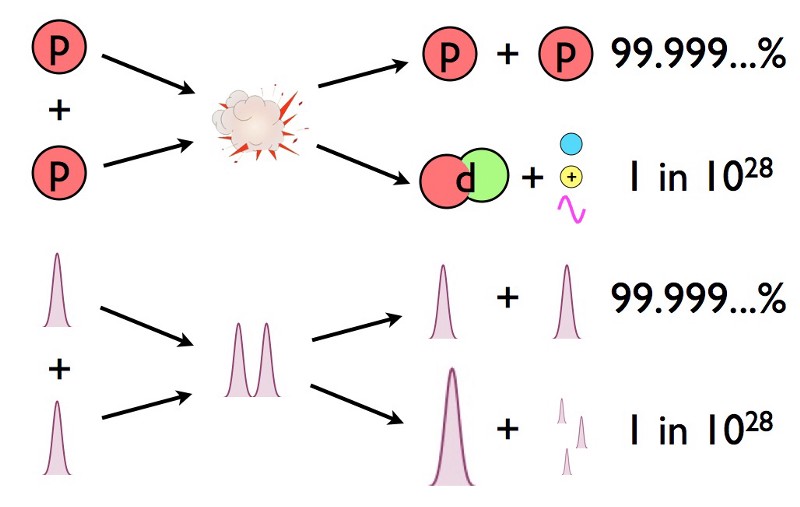
The synthesis process requires quantum physics: energy, even in the core of the Sun, where temperatures can exceed 15,000,000 K, is still not enough for their passage. Instead, at such temperatures there is a small quantum probability, of the order of 1 chance per 10 28 , that when a collision occurs, the particles tunnel into a heavier nucleus. But inside the Sun there are such densities and temperatures that every 4 * 10 38 protons merge into helium.

But these reactions do not occur close to the surface. Even with the help of quantum physics, a temperature of at least 4,000,000 K is necessary for the synthesis, and such temperatures end in about the middle of the radiation zone (more than 99% of the total synthesis occurs in the core). So, no, no fusion reactions feeding the Sun take place so close to the surface that their results reach our eyes.
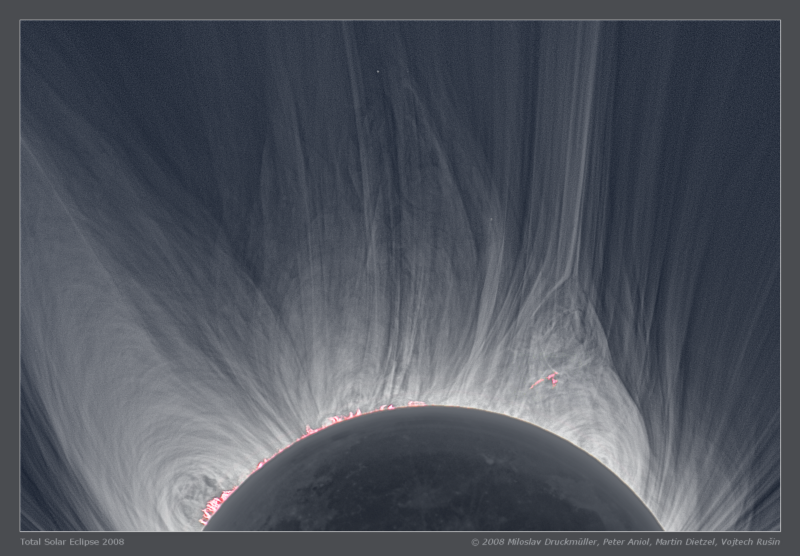
But something else happens on the Sun: its photosphere is surrounded by high-temperature plasma, the solar corona. This hot ionized plasma can reach temperatures of millions of degrees, in contrast to only 6000 K in the photosphere. In addition, there are solar flares emanating from inside the sun, mass emissions and other effects that increase the temperature of the sun in certain places.
And although these effects do not lead to the launch of additional nuclear fusion reactions, they change the energy emission profile. The spectrum that I showed earlier is just an idealized lie.
This is what the Sun really looks like.
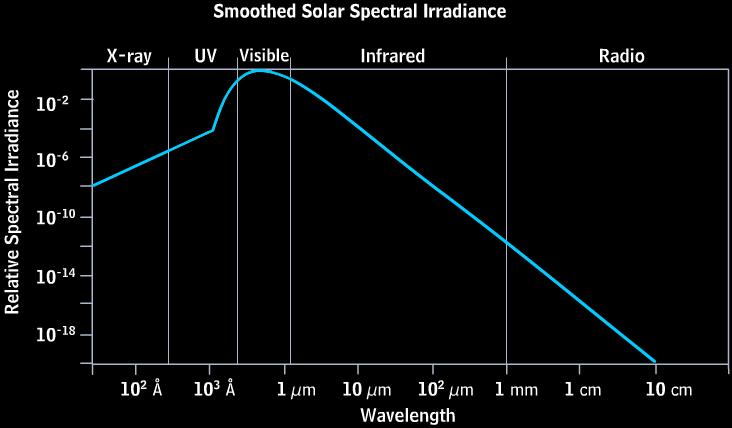
Notice how different it is. It is more energetic in the far ultraviolet and near-X-ray range (but there are still no gamma rays, sorry; only during flashes - and this is due to shock heating, and not due to nuclear fusion). The difference can be understood by considering the individual, specific wavelengths of light.
We observe that the visible light on the surface of the sun is fairly uniform (with the exception of colder spots), and the light close to ultraviolet follows approximately the same pattern. But with shorter waves and high energies, these energies are only achieved in areas of flares and the solar corona.

Light emanating from the outer layers of the Sun — from the photosphere and the corona — coincides with the radiation of any body in the Universe heated to a certain temperature. It simply does not emit it from a single surface of the Sun, but from a collection of absolutely black bodies, some of which are in the depths of the upper layers, where the temperature is higher, and others outside, in the photosphere, where the temperature is lower.
Therefore, considering the detail of the solar radiation spectrum, we see deviations from an absolutely black body not only at high energies, but also at all energies.

Therefore, in the end:
• Nuclear fusion reactions occurring inside the Sun go very deep, and no photons created in them get to the surface without experiencing many collisions.
• Light is emitted from the outer layers of the Sun, from the photosphere and the corona.
• The corona is the hottest part (why it is a separate topic), and it is responsible for most of the radiation in the ultraviolet and x-rays, but its contribution to visible light is small and can only be seen with complete eclipses.
• In light emitting regions, nuclear reactions do not occur, but sometimes because of flashes, shock heating occurs, resulting in the emission of high-energy gamma rays.

All this, strictly speaking, sunlight, and this is the closest to the answer "yes" option. The energy of the sun's insides heats all its various layers, including the outer ones, to the indicated temperatures. The atoms, heated to these temperatures, emit photons corresponding to these temperatures, and this is how sunlight is produced at all these different frequencies.
But if the essence of the question was whether nuclear reactions occur close enough to the surface so that we can see their immediate results, then the answer will be negative - unless you look at the Sun through a neutrino telescope.
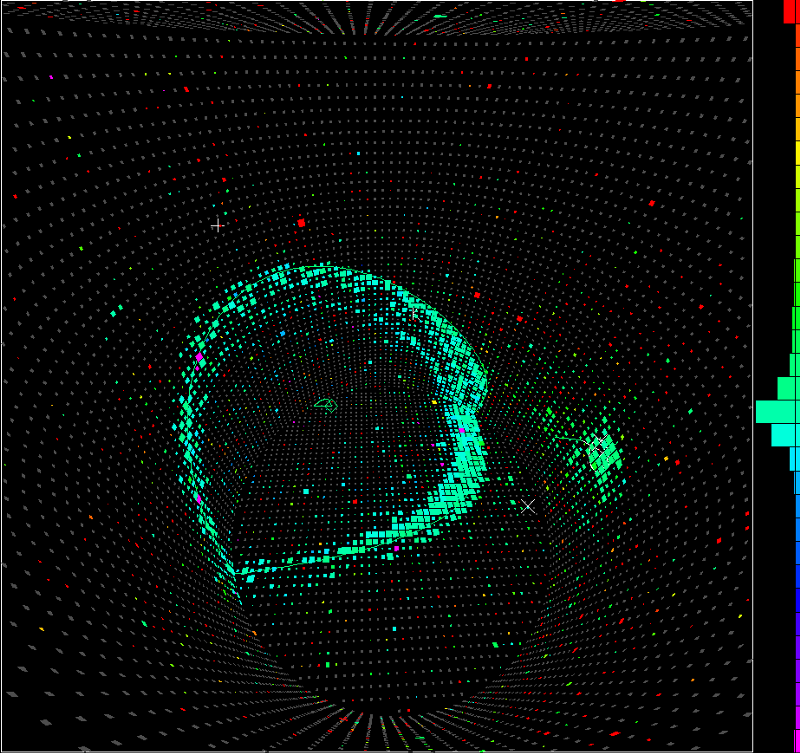
And in this case, yes, we will see them all!
Source: https://habr.com/ru/post/399401/
All Articles